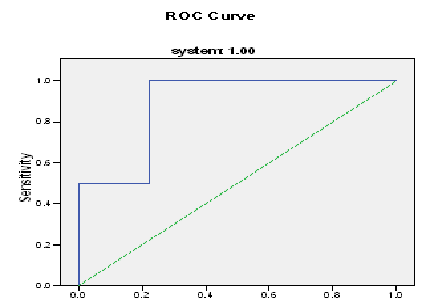Validation of SICK score - A severity of illness scoring system at a tertiary care centre in Puducherry
Abstract
Objectives: Validation of SICK score for its ability to predict out come. Validation based on predominant system involved.
Methods: Prospective study done at tertiary care centre in puducherry.
Inclusion criteria: All children admitted in PICU between 1 month & 12 year in 6 month period.
Exclusion criteria: Patients with surgical illness, congenital anomalies, non availability of consent. Physical variables of Temperature, Heart Rate, Respiratory Rate, Blood pressure, Capiallary Refill time, Oxygen saturation & sensoriurn (using AVPU scale) were recorded at the time of admission. SICK score was calculated and outcome was recorded as survived or expired. Association of patients outcome with total score was done using logistic regression analysis. The receiver operating characteristic (ROC) curve analysis was performed to decide the optimum cut off point in terms of total score that provides maximum sensitivity & specificity. Area under ROC curve (AUC) was used to compare the predictive power of total score. All analysis was carried out using SPPS software version 13.0.
Results: Total of 354 Children were analyzed. For SICK score of <1 mortality was 0%, which gradually increased to 100% with a score of 7 or more. The area under the ROC curve was 93% (95%: CI: 89.8% - 97.3%) indicating good predictive ability of the score.
Conclusion: SICK score has good predictive ability and uses only physical criteria. Further SICK score is not influenced by predominant system involved.
Downloads
References
2. Robertson M A,Molyneux E M,Triage in developing world-can it be done? Arch Dis Child 2001,85:208-13. adc.bmj.com/content/88/7/563.full.pdf. [PubMed]
3. PollackMM,RuttimannUE,GetsonPR.The Pediatric risk of mortality(PRISM) Score.Crit Care Med 1988,16:1110-16. https://www.ncbi.nlm.nih.gov/pmc/articles/PMC1763066/pdf/v087p00421.pdf
4. ChakrabartyA,HalsteadR,SahniM,RangasamyJ,PuliyelA,SreenivasV,GreenDA,PuliyelJM:Validation of “Signs of inflammation in children that kill”( SICK) Score for noninvasive assessment of severity of illness:Italian Journal of Pediatrics 2010,36:35. https://ijponline.biomedcentral.com/articles/10.1186/1824-7288-36-35.
5. ShannF,PearsonG,SlaterA,WilkinsonK. Pediatric Index of Mortality(PIM):A mortality prediction model in intensive care.Intensive Care Med 1997:23:201-07. https://www.ncbi.nlm.nih.gov/pubmed/9069007 [PubMed]
6. Robertson M A, Molyneux E M. Description of cause of serious illness and outcome in patients identified using ETAT guidelines in Urban Malawi. Arch Dis Child 2001; 85:214-17. archdischild-2013-305469v1.
7. Gove S, Tamburlini G, Molyneux E, Whitesell P, and Campbell H. Development and technical basis of simplified guidelines for emergency triage assessment and treatment in developing countries.Arch Dis Child. 1999 December; 81(6): 473–477. www.ncbi.nlm.nih.gov › Journal List › Arch Dis Child › v.81(6); 1999 Dec.
8. Thompson N, Coad N, Harnden A, Mayon white R. How well do vital signs identify children with serious infections in Pediatric Emergency Care? Arch Dis Child 2009 Nov; 94(11): 888-9. https://www.ncbi.nlm.nih.gov/pubmed/19608555.
9. Bhal S,TyagiV,KumarN,Sreenivas V PuliyelJM;Signs of inflammation that can kill(SICK)score:Preliminary prospective validation of a non invasive m3859;year=2006;measure of severity of illness.J PostgradMed2006;52:52:102-5.www.jpgmonline.com/article.asp?issn=0022
10. Mackway-Jones K: Emergency triage, Manchester Triage group; London BMJ Publishing group; 1997 (Pub Med). www.bmj.com/content/337/bmj.a1501.
11. Pal Comstedt, Merete Storgard and AnnMarie T Lassen. Systemic Inflammatory Response Syndrome in acutely hospitalized patients, a cohort study: Scandinavian Journal of Trauma, Resuscitation & Emerg Medicine 2009: 17-27. https://sjtrem.biomedcentral.com/articles/10.1186/1757-7241-17-67
12. Slater A, Shann F. Suitability of Pediatric Index of Mortality (PIM), PIM2, PRISM & PRISM III for monitoring the quality of pediatric intensive care in Australia and Newzealand Pediatr crit care Med 2004 Sep; 5(5): 447-54. https://www.ncbi.nlm.nih.gov/pubmed/15329160.
13. Wells M, Reira-Fanego JF, Luyt DK, Dance M, Lipman J. Poor discriminatory performance of the pediatric risk of mortality (PRISM) score in South African Intensive Care Unit. Crit care med 1997; 25: 716-7. https://www.ncbi.nlm.nih.gov/pubmed/8797623.
14. John M, Goddard FC. Pediatric Risk of Mortality (PRISM) score overestimates the severity of illness in infants. Crit Care Med 1992; 20:1662-65. [PubMed]
15. Steven D Burdette, Miguel A Parilo, Lewis J Kaplan, Heatherlee Bailej. Systemic inflammatory response syndrome. E Medicine specialties (updated Apr.15, 2010) URL:http://www. emedicine. com /med/topic2227.html.
16. Sayagama A, Aikawa N. Evaluation of systemic inflammatory response syndrome criteria as a predictor of mortality in patients transported by ambulance Keio J Med 1999 Mar; 48(1):28-37. www.ncbi.nlm.nih.gov/pubmed
17. Maria Antonette Enrione and Keith R Powell. Sepsis, septic shock and systemic inflammatory response syndrome. In; Behrman, Kliegman, Jension. Nelson Textbook of pediatrics, Saunders Company, Philadelphia 18th ed (Published in India by Elsevier, a division of India private limited) 2008: 1094-99.
18. Mackway Jones K, Molyneux E, Philips B, Weeteskas. Structured approach to the seriously ill child. In: Advanced pediatric life support. onlinelibrary.wiley.com/doi/10.1002/9781119241225.ch4.
19. The practical approach. BMJ Books, 3rd Edition. Panther publishers Bangalore 2001;pp: 71-78.
20. Mc Carthy P L, Grundy G W. Bacteremia in children: an outpatient clinical review. Pediatrics 1976; 57:861-868. jamanetwork.com/journals/jamapediatrics/fullarticle/514274
21. Campbell H, Byass P, Greenwood B M. Simple clinical signs for diagnosis of acute lower respiratory infections. Lancet. 1988; 2: 742-743. https://www.ncbi.nlm.nih.gov › NCBI › Literature › PubMed Central (PMC).
22. Cherian T, John T J, Simoes E, Steinhoff M C, John M, Evaluation of simple clinical signs for diagnosis of acute lower respiration tract infection. Lancet. 1988; 2: 125-128. https://www.ncbi.nlm.nih.gov › NCBI › Literature › PubMed Central (PMC).
23. Horari M, Shann F, Spooner V, Meisner S, Carney M, Decampo J. Clinical signs of pneumonia in children. Lancet. 1991; 338: 928-930. thelancet.com/journals/laninf/article/PIIS1473-3099(15)70017-4
24. Kevin Gunning, Kathy Rowan. Outcome data and scoring systems. BMJ 1999; 319: 241-44. www.bmj.com/rapid.../2011/.../mpm-preferable-apache-intensive-care-scoring-system
25. Circulation, Chapter 7, Facility based Integrated management of Neonatal and childhood illness (F.IMNCI) Participants Manual; 28-34. www.health.mp.gov.in/manuals/STG-2016.pdf
26. Tibby S, Murdoch I A. Monitoring cardiac function in intensive care. Arch Dis Child 2003; 88: 46-52. https://www.ncbi.nlm.nih.gov/pubmed/12495962.
27. Onyngo F E, Steinhoff M C, Wafula E M, Ariua S W, Musia J, Kitonyi J. Hypoxemia in young Kenyan children with acute lower respiratory tract infection. BMJ 1999; 306: 612-615.



 OAI - Open Archives Initiative
OAI - Open Archives Initiative


